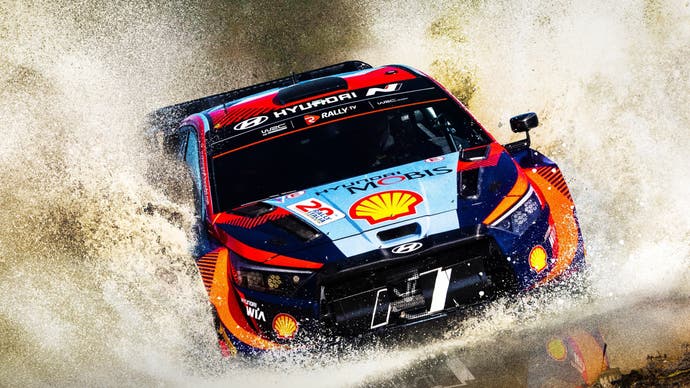EA Sports WRC: an engine change for the worse?
PC, PS5, Series X and Series S analysed.
UK developer Codemasters has a rich 37-year history of racing games, with its own EGO Engine used to create every flavour of racing game you could imagine. From the tarmac racing in F1 and Grid to the off-road thrills of Dirt and the more realistic Dirt Rally, it has every base covered. But the times are changing, and so is the technology. In 2020, Dirt 5 switched to an evolved form of the Onrush engine instead - to great success - while this year the launch of EA Sports WRC sees a more radical break with the studio deploying Unreal Engine 4.
This fascinating transition raises some questions. Have the visuals truly benefitted from the change? In comparison to the likes of Dirt Rally 2.0 - an EGO Engine title that was handled by the very same team in 2019, is the rally experience of EA WRC improved? And how does it run today on PlayStation 5, Xbox Series X, S and PC? That's what we've aimed to find out with testing on all four platforms.
The official reason for the engine change, based on developer interviews, is to allow for larger circuits. In EA Sports WRC it's possible to map out rally routes of up 30km in length. Seemingly there was a size limit with its own EGO Engine tech, and Unreal Engine 4 allows the team to break through this barrier. And no doubt, the jump to Unreal Engine also allows Codemasters to reap certain benefits native to the tech like platform scalability and Epic's TAAU upscaler. Plus, it's clear that WRC makes for a good test-bed to see if the engine is suitable future games.
While the rendering technology has changed with the new engine, the team's existing multi-surface handling model and car physics are still in place. It's also worth underlining that Codemasters opted for the older Unreal Engine 4 first, rather than going for UE5 with all its latest features. As such, the likes of Lumen and Nanite are off the cards in EA Sports WRC, a shame given each technology has a lot of potential for a racing title. Also curious is the platform choice: EA Sports WRC is only available for the current console generation this time, comprising of PS5, Xbox Series X, Series S - plus PC.
The turnout for EA Sports WRC's visuals are very mixed. To be blunt, the upgrade over 2019's Dirt Rally 2.0 isn't always evident, and at times it takes a backwards step in image quality and frame-rates. Chiefly, it's a shame there's no push for ray tracing features here - and nor is there a 120Hz mode on PS5 or Xbox Series X, as we have in Codemaster's F1 23 which still runs on the EGO Engine. The game does however support AMD's FSR 2 and Nvidia's DLSS 3 image upscaling and frame generation on PC at least, in a way to help with the high demands of VR support. Otherwise, the result is not always a clear progressive step forward.
Perhaps the most obvious point of comparison is Dirt Rally 2.0 - the team's last EGO engine rally title. In booting Dirt Rally 2.0 today on an Xbox Series X, so much holds up even four years on. It's in the way light hits polished car bodies, the way tyres leave imprints in the mud and even the high density of grass in the New Zealand stage. The mud build-up on cars, damage deformation and the glare of the sun are all well represented. Certainly tracks are not as expansive as its latest rally effort, but the game runs at a locked 4K 60fps on Series X - neither of which is quite the case with EA Sports WRC.
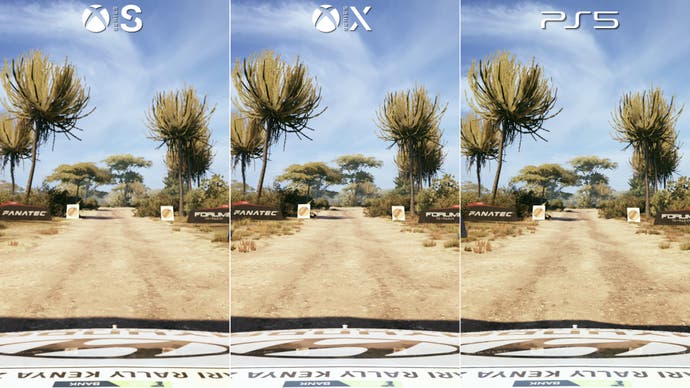
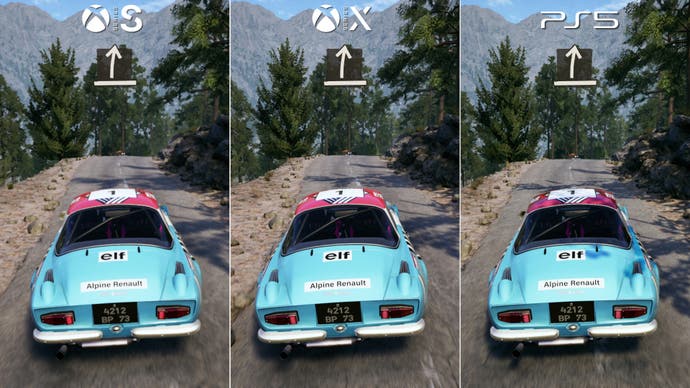
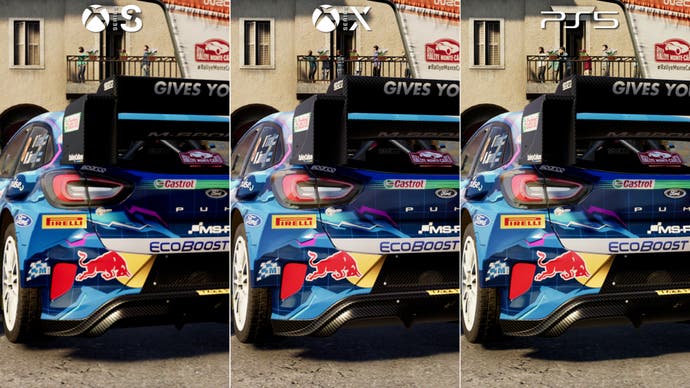

Switching to EA WRC, it's possible to see some upgrades. There's a frankly great variety of cars, huge sprawling stages and a handling model that rewards practise across different terrain types. Beyond this, rock geometry is visibly more detailed, while weather states and seasonal changes to terrain are all well-worked additions. It's impossible to get a perfect 1:1 comparison to Dirt Rally 2.0 with all these variables - and no common track between them - but it's certainly hard to parse a generational leap from one game to the next. Indeed, it's conceivable the game could port well to older PS4 and Xbox One systems with a drop in resolution and settings.
There are clear rough spots here too. You'll spot screen tearing and frame-rate drops on PS5 and Series X, with a visibly sub-4K resolution on the premium machines that goes as low as 1080p. There's also the issue of camera judder, which is unrelated to the frame-rate and afflicts every console and PC. It's most noticeable in the opening panning shot around your car, where the camera jerks and stops rather than moving smoothly through space - even when the game is running at 60fps.
EA Sports WRC doesn't offer any graphics modes on console either. You get a single way to play, with PS5 and Series X each targeting 4K with dynamic resolution scaling, and 60fps as the target. Resolution figures like 1296p (60 percent of 4K) are a common measurement here, but the fact is, in the upscale to a 4K display the result isn't as sharp as Dirt Rally 2.0's often true native 4K picture on the latest consoles. Series S also unsurprisingly runs at low figures, with a 1440p target that can dip to 720p. Otherwise, Codemasters has openly revealed that both Series X and PS5 run at equivalent to PC's high settings, while Series S settles for a mixture of medium and low.
In comparison, it's notable that PS5 and Series X owners get a similar package in visual terms, while frame-rates are close too. The only sticking point is that PS5 gets higher quality shadows - sharpening their outlines - whereas the Xbox Series X and S machines share the same shadow settin. Regardless, Series X and PS5 look quite similar in motion in every other aspect. It's Series S that operates with the most noticeable drop to settings quality in general and resolution.
Honing in on the Xbox Series consoles, there's a few trade-offs to getting Series S running at 60fps. Drops to an internal resolution of 720p tends to cause fine detail like power cables or metal fences to break up, with too little pixel detail to construct the actual line. Beyond that, you'll spot a reduction in shadow quality draw distance, while foliage density is reduced. Less frequent pockets of spectating crowds are thinned out in towns too. The rest of the differences fall into nit-pick territory: ambient occlusion quality is dropped, and there are lower quality reflections across car bodies on Series S.
I had a chance to check out the PC version too, on a well-equipped system with an RTX 4080 graphics card and Ryzen 7 5700X processor. This provided enough horsepower to hit a native 4K at ultra settings, providing a similar step up in image quality as going from Series S to Series X. In this case, foliage density and draw is boosted even further, as is shadow resolution, ambient occlusion quality and reflection quality. The resolution upgrade to a genuine native 4K is the most obvious change though, especially visible in the clarity of fine elements like trees. You also get the ability to push beyond 16:9 aspect ratios and above 60fps gameplay, with more multi-monitor options set to arrive in the future.
.jpg?width=690&quality=75&format=jpg&auto=webp)
.jpg?width=690&quality=75&format=jpg&auto=webp)
.jpg?width=690&quality=75&format=jpg&auto=webp)
Let's talk performance then. Jumping back to PS5 and Series X first, the most typical frame-rate is indeed 60fps - but there are also unmissable drops to ~50fps with full screen tearing. I've seen this on the Monte Carlo stage beyond the four minute mark - and it's repeatable on every console. Another big stress point is in busy town segments with crowds, heavily forested areas, and especially replays after the race. These frame-rate drops interfere with the input response on-screen, and it's a shame to see that 60fps is now a challenge at points, given that the previous EGO and Onrush engines both pushed 120fps on PS5 and Series X.
Switching to Series S though, there is some good news here at least. For all its visual downgrades, performance is on par or better than Series X. Now the drops and the tearing still happen in the exact same spots, but there are other segments that run at 60fps where PS5 and Series X do not, such as the Imola stage. In this sense, it's the best performing version of the three - though when the GPU is pushed we're still getting tear-lines and lots of dropped frames. I've also spotted many comments pointing out occasional hitching on console, though I haven't experienced this yet as of version 1.3. Still, it's something to be aware of.
Returning to PC performance on our RTX 4080 machine, this version has been patched since launch to improve shader compilation stutters - but it's still not 100 percent fixed. Any first brush with a shader effect, like water splashes or collisions with geometry can result in an immersion-breaking hitch. Even the arrival of new pacenotes can trigger a drop. Eventually the shader cache does fill up with the relevant data to avoid most drops, but it's still a blemish on the package and hardly makes for a great first impression.
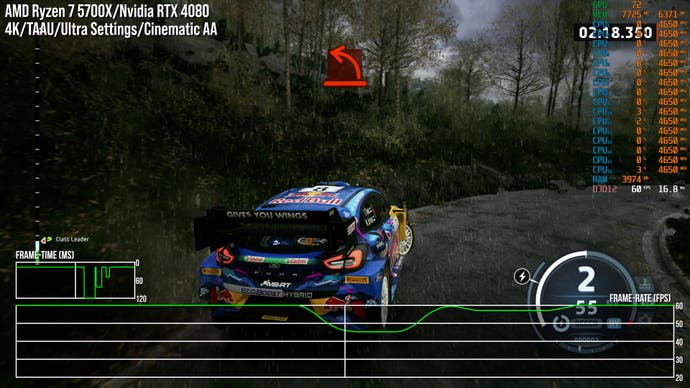
In terms of general performance, at least the frame-rate is a robust 60fps with plenty of places to claw back GPU performance by turning down settings - though the camera judder issue is more pronounced on PC, with even the motion of the chase cam refreshing at uneven intervals. Combined with the shader compilation stutters, any sense of control you have over your car is negatively impacted and the result is an experience that's worse than the game on console.
Looking at PS5, Series X and S, it's still not the ideal experience there either. EA WRC runs at below 60fps at points, even on the most powerful consoles on the market today, and all of the maps and vehicles in the world do not solve these core performance issues.
As the first Unreal Engine racing title by Codemasters, EA Sports WRC gets a lot right in terms of its content, its handling model and its overall feel - but if UE is the future for Codemasters, we must expect a lot more in features, visual upgrades and performance stability.
